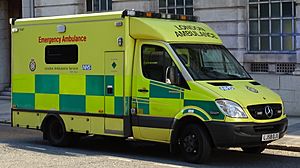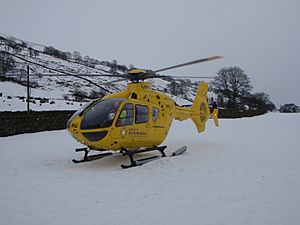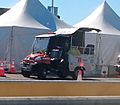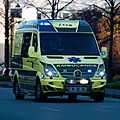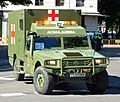Ambulance facts for kids
An ambulance is a special vehicle designed to carry people who are sick or hurt. These vehicles usually rush to emergencies to take patients to a hospital. Emergencies can include serious situations like heart attacks, strokes, bad bleeding, broken bones, or trouble breathing. They also help people injured in accidents, like car crashes or falls.
The very first ambulances were used on battlefields. They were horse-drawn carts that moved wounded soldiers to field hospitals after a fight. By the 1800s, horse-drawn ambulances became common in Europe and North America as hospitals grew. In the early 1900s, cars replaced horses. Today's ambulances are often vans that have been changed into small mobile clinics. They can give first aid, emergency care, and even life support. They also carry patients safely to the hospital.
Ambulances usually have trained medical staff on board. These include EMTs (Emergency Medical Technicians) and paramedics. They carry special equipment and medicines to help keep people alive. They also have tools for delivering babies in an emergency or restarting a heart.
To call an ambulance, you dial a special emergency number. This number is different in each country. For example, it's 999 in the United Kingdom, 911 in the United States, and 112 in most of Europe. An emergency medical dispatcher then sends an ambulance to help.
Contents
Who Works on an Ambulance?
An ambulance usually has two people working as a crew. This way, one person can drive while the other takes care of the patient in the back.
Paramedics and EMTs
A paramedic has at least a year of medical training. They can give advanced medical treatment. Not all ambulance staff are paramedics. Those with less training are called emergency medical technicians (EMTs) in some countries, like the United States. In the United Kingdom, they might be called emergency care assistants (ECAs). In some places, like France or Germany, ambulances might even have doctors or nurses on board.
What Equipment Do Ambulances Carry?
In the past, ambulances mainly just gave patients a ride to the hospital. Some only had a basic first aid kit. This is still true in a few parts of the world. But modern ambulances have much more equipment and medicine. In many countries, an ambulance is like a small, moving doctor's clinic.
Besides medicine and bandages, ambulances often have these important items:
- Collar: This special collar holds a person's neck still if they might have hurt their backbone.
- Defibrillator: This machine uses an electric shock to help restart a heart that has stopped beating.
- Entenox gas cylinders: Also known as "laughing gas," this gas helps reduce pain when a person breathes it in.
- Heart monitor: This machine shows how well a person's heart is beating.
- Oxygen gas cylinders: We breathe oxygen from the air around us. But if someone is having trouble breathing, giving them extra oxygen from a cylinder can help a lot. They wear a small mask for this.
- Splints: These hold a broken arm or leg in place. This stops the broken bone from getting worse during transport.
- Stretcher or scoop: These are used for safely carrying the patient in and out of the ambulance.
- Wheelchair: Another way to move a patient who can sit up.
When driving to an emergency, ambulances can break some road rules. For example, they can drive faster than the speed limit or go through a red traffic light. They use flashing lights and loud sirens to warn other drivers to get out of the way.
What is an Air Ambulance?
Air ambulances became more common in the late 1900s. These are usually helicopters that carry the same kind of equipment as a regular ambulance on the ground. In the United States, the Coast Guard has a public air ambulance service using helicopters. There are also private air ambulance services that can transport patients over longer distances, even internationally.
Air ambulances are very important in countries where people live far apart. This includes places like Canada, Russia, parts of the USA, Sweden, or Finland. They can often save a patient's life by getting them to a hospital much faster than a ground ambulance could.
Images for kids
-
Fiat Ducato ambulance in Great Britain.
-
Queen Elizabeth II (then Princess) next to a British Army ambulance in 1945.
-
Early car-based ambulances, like this 1948 Cadillac Meteor, were sometimes also used as hearses.
-
Many modern Canadian and European ambulances are built on the Mercedes-Benz Sprinter chassis.
-
A van-based Volkswagen Crafter ambulance in the Czech Republic.
-
The interior of a mobile intensive care unit (MICU) ambulance from Graz, Austria.
-
An ambulance in New South Wales, Australia with special markings for visibility.
-
An ambulance from St John Ambulance WA in Perth.
-
A volunteer ambulance crew in Modena, Italy.
-
Various ambulance crews help to load a patient into an air ambulance in Pretoria.
-
A retired Ford E-Series ambulance reused as a logistics unit.
-
An ambulance in Switzerland.
-
A New York City Fire Department ambulance.
-
A Toyota HiAce Commuter ambulance in Malaysia.
-
A van bodied ambulance built for the Abu Dhabi National Ambulance.
-
An Audi A4 Avant fly-car in Germany.
-
An air ambulance in Austria.
-
An air ambulance in Australia.
-
A water ambulance in the Scilly Isles.
-
A Norwegian boat ambulance operating on the coast of Helgeland.
-
A typical American ambulance, operated by the Longboat Key fire department.
See also
 In Spanish: Ambulancia para niños
In Spanish: Ambulancia para niños


